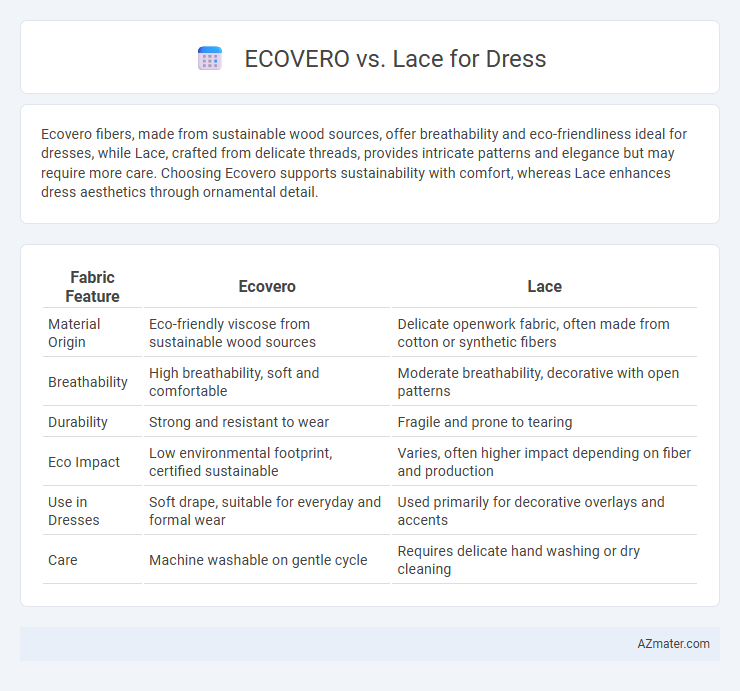Ecovero fibers, made from sustainable wood sources, offer breathability and eco-friendliness ideal for dresses, while Lace, crafted from delicate threads, provides intricate patterns and elegance but may require more care. Choosing Ecovero supports sustainability with comfort, whereas Lace enhances dress aesthetics through ornamental detail.
Table of Comparison
| Fabric Feature | Ecovero | Lace |
|---|---|---|
| Material Origin | Eco-friendly viscose from sustainable wood sources | Delicate openwork fabric, often made from cotton or synthetic fibers |
| Breathability | High breathability, soft and comfortable | Moderate breathability, decorative with open patterns |
| Durability | Strong and resistant to wear | Fragile and prone to tearing |
| Eco Impact | Low environmental footprint, certified sustainable | Varies, often higher impact depending on fiber and production |
| Use in Dresses | Soft drape, suitable for everyday and formal wear | Used primarily for decorative overlays and accents |
| Care | Machine washable on gentle cycle | Requires delicate hand washing or dry cleaning |
Ecovero vs Lace: An Overview
Ecovero fabric, derived from sustainable wood pulp, offers superior breathability and environmental benefits compared to traditional lace, which is often made from synthetic fibers. Ecovero's eco-friendly production reduces water and chemical use by up to 50% versus conventional viscose, making it a preferred choice for environmentally conscious dressmakers. In contrast, lace provides intricate patterns and texture but lacks the sustainable credentials and moisture-wicking properties characteristic of Ecovero.
Origins and Production Processes
Ecovero fibers are derived from sustainably sourced wood pulp, primarily from certified temperate forests in Europe, and undergo a closed-loop production process that minimizes water and chemical use. Lace for dresses typically involves intricate fabric craftsmanship using cotton, silk, or synthetic fibers, produced through weaving or knitting techniques often carried out in traditional textile centers with varying sustainability practices. The key distinction lies in Ecovero's eco-friendly viscose manufacturing emphasizing renewable materials and reduced environmental impact, whereas lace production focuses on artisanal fabric creation with less standardized environmental accountability.
Environmental Impact Comparison
Ecovero fabric, derived from certified renewable wood sources, offers a lower environmental impact by reducing water usage and greenhouse gas emissions compared to traditional viscose production, making it a sustainable choice for dress materials. Lace, often made from synthetic fibers like nylon or polyester, typically involves higher energy consumption and non-biodegradable waste, contributing more significantly to pollution and landfill burden. Choosing Ecovero dresses supports eco-friendly fashion with a smaller carbon footprint, while conventional lace dresses tend to have a heavier environmental load due to their synthetic origins and production processes.
Texture and Comfort Differences
Ecovero fabric offers a smooth, breathable texture derived from sustainable wood fibers, providing a soft and lightweight feel ideal for warm weather dresses. Lace fabric, known for its intricate openwork patterns, delivers a delicate and airy texture but can sometimes feel slightly rough against the skin without a lining. While Ecovero emphasizes moisture-wicking comfort and eco-friendliness, lace prioritizes aesthetic elegance with moderate comfort depending on its weave and layering.
Durability and Longevity
Ecovero fabric, derived from sustainably sourced wood pulp, offers enhanced durability due to its resistance to shrinkage and tearing, making it ideal for long-lasting dresses. Lace, while delicate and intricate, is prone to snags and wear over time, which may reduce its longevity compared to Ecovero. Choosing Ecovero ensures a balance of eco-friendly material with superior strength, whereas lace prioritizes aesthetic appeal but requires more careful maintenance.
Versatility in Dress Design
Ecovero fabric offers sustainable versatility with its eco-friendly viscose fibers, providing lightweight, breathable qualities ideal for flowing dresses and tailored silhouettes. Lace, known for its intricate patterns and delicate texture, enhances dress design with elegance and ornamental appeal, suitable for formalwear and layering accents. Both materials support diverse dress styles, but Ecovero excels in comfort and sustainability, while lace adds sophistication and decorative detail.
Maintenance and Care Requirements
Ecovero fabric requires gentle washing with mild detergents to preserve its eco-friendly properties and prevent fiber damage, preferably in cold water to maintain its softness and durability. Lace, being delicate and often intricate, demands hand washing or use of a mesh laundry bag on a gentle cycle, avoiding bleach and harsh chemicals to prevent tearing and discoloration. Both fabrics benefit from air drying flat to maintain shape and prevent shrinkage, but lace requires extra caution to avoid snagging on rough surfaces during the drying process.
Price and Accessibility
Ecovero fibers, derived from sustainable wood pulp, typically come at a higher price point due to their eco-friendly production process, making them less accessible in budget-conscious markets. Lace dress options using conventional materials are generally more affordable and widely available across various retail platforms. Consumers seeking sustainable fashion might face limited accessibility and increased costs with Ecovero-based lace dresses compared to traditional lace alternatives.
Style and Aesthetic Appeal
Ecovero fabric offers a sustainable, eco-friendly choice with a smooth texture and vibrant colors that enhance the dress's sophisticated look, ideal for modern, elegant styles. Lace provides intricate patterns and delicate detailing, adding a timeless, romantic aesthetic with a vintage charm perfect for formal or bridal wear. Choosing between Ecovero and lace depends on the desired combination of sustainability and classic ornamental appeal in dress design.
Choosing the Best Fabric for Your Dress
Ecovero, a sustainable viscose brand, offers breathable, eco-friendly fabric ideal for draping dresses with a soft, smooth texture that enhances comfort and style. Lace, known for its delicate, intricate patterns, provides a lightweight, elegant look perfect for formal occasions but requires more careful maintenance due to its fragility. Choosing the best fabric depends on the desired dress style, occasion, and sustainability preferences, with Ecovero excelling in everyday wear and lace standing out for decorative, statement pieces.

Infographic: Ecovero vs Lace for Dress
 azmater.com
azmater.com